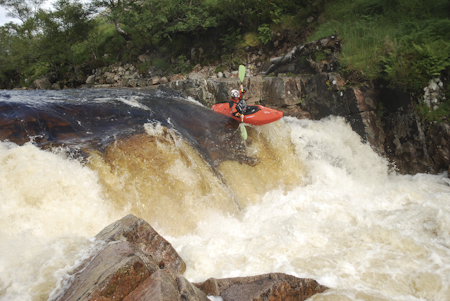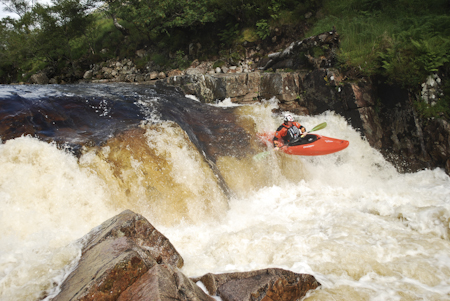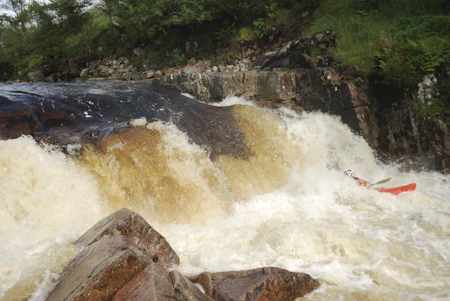Boofarama
Moving on with the techniques, the boof is a skill which can open up a new level of white water. If it isn’t new to you, then a bit of time brushing up won’t be wasted!
Prerequisites
Being comfortable on grade 3 white water, with confident and effective use of strokes and body positioning to make your way smoothly down rapids. Although you don’t tend to need a boof to paddle grade 3, there’s often a little ledge around to practice on and get the timing right before you move to grade 4 where technical manoeuvres are more essential and mistakes are more severe. The final and regularly overlooked prerequisite is outfitting, you need to make sure you fit snugly in your creek boat with plenty of comfortable contact on your footrest, thigh grips and hip pads!
Positioning
First of all, with ledges, which require a boof, it’s best to have a think about positioning. I rarely boof a drop directly in the middle but instead always aim to boof at the edges, generally because this is where the hole that waits below will be weakest. In the case of angled ledges my general rule is to boof on the side furthest downstream as this will also be the weakest and quickest exit from the hole.
Boofing on the side of the ledge furthest downstream in case of any mishaps!
Timing
Before you charge at a ledge in hope that speed will save you, think about your timing. A good boof requires finesse, not a flurry of brute force and ignorance! Think about your strokes leading up to the ledge so you can make sure you’re ready with the placement of a long powerful stroke at your toes when you reach the lip of the ledge.
Body positioning through the stroke
The stroke planted at your toes puts you in a forward, aggressive body position. That’s good, as while your blade is the power, your body is the leverage to lift the bow and in it’s forward position, is wound up ready to ping back and lift!
Leant forward waiting for the right moment.
As you pull the stroke through keep it close to the side of your boat, to avoid doing a powerful sweep stroke and landing sideways in the hole – a common mistake. The stroke has to be long, to see you over and past the hole. Stopping the stroke short is also a regular mistake, leaving you motionless and with no leverage or power in a nosedive!
Torso moving back with the stroke and legs following to pull the bow up.
As the stroke goes through, your torso position starts moving back, beginning to lift the bow. As you feel your body going through it’s central position pull on your knees as if pulling them into your chest. This uses your thighs and core muscles to powerfully lift the bow better than any amount of speed or paddle power could.
Long stroke holding the line and angle.
Follow through
Having a well timed, long stroke is vital, not only to aiding body positioning and power but also in the follow through. If your boof stroke was long, then your opposite blade will be forward ready to be planted for a powerful stroke away from the ledge. This is very good practice and has certainly spared me a few beatings when it hasn’t gone to plan.
Left blade forward ready in case it’s needed.
In a nut shell
- Position near safest edge of the ledge
- Plant stroke at the lip
- Let torso go back with the stroke
- Pull knees to chest as torso goes through central position
- Make sure your stroke is long
- Opposite blade ready for powerful stroke out
See you on the water… surf is epic in Cornwall at the mo!
Ed
TrackBack URL :












